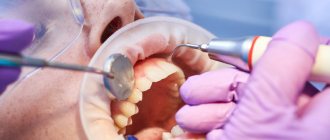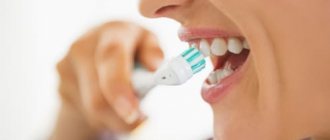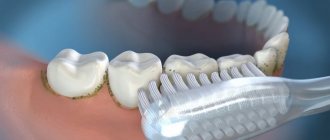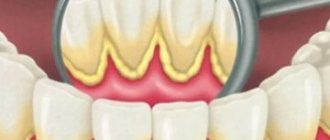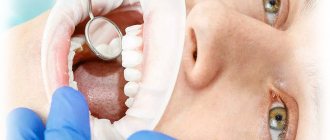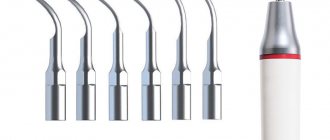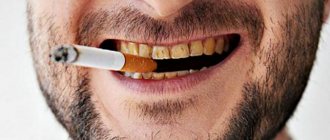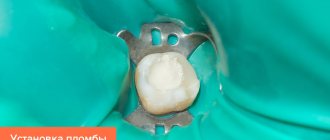Soft plaque that is not removed in time turns into stone over time.
Plaque forms constantly in the oral cavity, since the process of microflora reproduction does not stop (its intensity especially increases after eating). If soft deposits are not removed, they gradually become saturated with mineralized salts contained in saliva and harden (on average, mineralization occurs within 16 hours after eating, but this figure may vary slightly, both smaller and larger).
Why does tartar form?
The appearance of tartar can occur for a number of reasons:
- Poor oral hygiene. First of all, you need to choose the right toothbrush - it should have bristles of different lengths and shapes. It is equally important to use a toothpaste that can effectively cope with plaque – it must have an abrasiveness index of at least 50 RDA.
- Unbalanced diet. Foods high in carbohydrates – flour, pasta, carbonated sweet water, etc. – provoke stone formation.
- Drinking strong black tea and smoking regularly. The latter is especially dangerous, since heated smoke intensifies the inflammatory process in the gums.
- Violation of pH levels. When it decreases, the acidity of saliva increases, as a result of which more minerals and salts are deposited on the surface of the teeth. If the level, on the contrary, increases, the acidity of saliva decreases, which affects the enamel, which becomes more loose.
- High content of fluoride and calcium in saliva. The ions of these components accelerate the formation of tartar.
- Uneven bite. The distance between crowns is a good place for plaque to accumulate.
- Orthopedic fixed structures in the mouth (plaque accumulates in the gaps between dentures and stones form).
- Thyroid diseases and diabetes. These diseases are accompanied by disruption of endocrine processes, which leads to changes in the acidity of saliva.
- The absence of several teeth, which affects chewing. If a person has no teeth on one side, he spontaneously begins to chew on the other side of his mouth. As a result, teeth do not undergo the natural self-cleaning procedure, so plaque accumulates on them.
- Too increased or, conversely, decreased production of saliva due to disturbances in the functioning of the salivary glands.
- The use of medications that affect the composition of saliva.
Proper brushing of teeth to remove plaque
Bass technique has been developed to remove food debris from the gum area. It is performed according to the following algorithm:
- Apply paste to brush
- Rinse your mouth with water
- Position the brush parallel to the teeth
- Slightly tilt the brush approximately 45 degrees.
- Move the device without pressing
- Then move in a circle, trying to get the bristles between the teeth
- Go over the entire jaw 15-20 times
- Move in a circular motion along the side teeth
- Do not ignore your tongue; 80% of pollution accumulates on it.
- Remove plaque from tongue
- There are brushes with a rough or bumpy back wall, specially made for cleaning this organ.
- After the outer part is completed, it is necessary to move on to the back wall of the incisors and molars. To do this, the brush is placed vertically with its bristles.
- It is recommended to carry out the procedure near a mirror to see the correctness of your actions.
As you can see, problems in the oral cavity and teeth occur in most cases due to non-compliance with hygiene rules.
Residues of food and the accumulation of bacteria on them create a plaque that hardens over time and cannot be removed by regular cleaning.
This is not only an aesthetic defect, but also serves as the basis for the development of dangerous diseases.
Brushing your teeth twice a day and regular dental check-ups will help reduce the risk of formations.
Types of tartar
Tartar consists of one third of organic substances (epithelial cells, microorganisms, proteins, etc.) and 2/3 of inorganic substances (mainly calcium salts).
Stones are divided into:
- supragingival, which, as you can guess from their designation, are located above the gum. They are easy to see with the naked eye and are dark yellow in color. Removing such deposits is quite simple.
- subgingival. During a routine examination, they cannot be noticed, but their presence can be assumed by the bluish tint of the gums and increased bleeding in this place. It is possible that pus may be released from the periodontal pocket.
The presence of subgingival stones is the first sign of periodontitis and the beginning of tissue destruction around the tooth. Only a dentist can detect stones located under the gum by probing the pockets. Removing subgingival stones takes a lot of time, so not every doctor will undertake such work.
Postoperative actions
After any type of cleaning, you need to rinse your mouth with some of the products listed below.
- Causes of tartar formation
| Medicinal substance | Breeding method and benefits |
| Sage | It has antimicrobial and anti-inflammatory effects. Dilute one teaspoon per glass of boiled water, close and leave for half an hour. Then strain and rinse four times a day. |
| Chamomile | This plant has a good antiseptic effect. Can also be used for many other diseases. Dilute one tablespoon per glass of boiling water. Close and after twenty minutes strain and rinse. Rinse three times a day. |
| Tincture of calendula | Like all the herbs given above, it is a natural antiseptic. Dilute one teaspoon per glass of boiled water. Close and strain after half an hour. Rinse also three times a day. |
Tartar: causes of appearance
Leftover food in the mouth after eating is a favorite treat for bacteria. Such microorganisms especially love the so-called “fast” carbohydrates, found in large quantities in flour products and sugar. It has been proven that even if oral hygiene is neglected one day, this will lead to accelerated plaque formation, increasing in volume several times over this period of time.
Bacteria need nutrients both to maintain vital processes and to produce enzymes that allow them to securely attach to the tooth surface. If you brush your teeth poorly, individual bacteria will begin to form colonies, which, in turn, can also merge with each other. Nevertheless, at this stage, eliminating plaque is not yet particularly difficult - you can get rid of it by working well with a toothbrush.
Over time, the plaque will mineralize (calcium salts and proteins present in saliva will begin to settle on the surface of the bacteria, which will proceed in parallel with the formation of new colonies), hardening and increasing in volume.
At the same time, toxins will be released from the plaque, causing the development of the inflammatory process. You can understand that inflammation has begun by pain in the gums, their bleeding during brushing, the flow of pus and increased tooth mobility.
The inflammatory process is of great importance for bacteria: the groove between the gum and tooth constantly receives liquid rich in proteins necessary for bacteria to grow; inflammation increases the formation of this fluid, accordingly, microorganisms receive more proteins, and the growth rate of their colonies becomes higher.
Concluding all of the above, the appearance of a stone is a direct consequence of non-compliance with hygiene.
How to remove tartar
If the plaque has formed into stone, then it will no longer be possible to get rid of it with an ordinary brush.
Tartar cleaning in Krasnodar is the only effective way to eliminate deposits. The professional method involves the use of ultrasonic cleaning: removing tartar from all teeth takes about one hour, if we are talking about supragingival deposits. To eliminate subgingival stone, you will have to visit the doctor several times, if his qualifications are sufficient to carry out the procedure.
It is better to immediately contact a periodontist rather than a therapist. This is especially true for people suffering from periodontitis, since they may have stones in the resulting pockets. If it is necessary to clean tartar located above the gum level, then a dentist-therapist will also help.
The cost of tartar removal in our clinic is 3,500 rubles. This includes polishing the teeth with a brush and toothpaste. Polishing teeth using a PROPHY flex device (a mixture of water, compressed air and fine sodium bicarbonate powder - baking soda).
Tartar: how to get rid of it at home
Most people understand that the best way to resolve any dental problems is to visit the dentist. However, not everyone likes to contact a specialist, delaying the visit until the last minute in the hope that the problem will somehow resolve itself. This is largely facilitated by advertising offering treatment for all occasions.
So how to remove tartar at home? Unfortunately, no way. Even the most expensive products will not be able to remove thick plaque and stone. However, ultrasonic or electric brushes, as well as special toothpastes, will help get rid of the soft plaque that is just beginning to form.
Consequences of stones
If the stones are not removed, this can lead to:
- the appearance of bad breath (its cause is the vital activity of microorganisms that have settled on the surface of the teeth);
- the formation of caries (bacteria in the process of life produce hydrochloric acid, which corrodes the enamel, which contributes to the onset of decay);
- inflammation of the gums, their bleeding, which can subsequently result in periodontitis;
- diseases of the mucous membrane (accumulation of colonies of microbes on the teeth can lead to ulcers and erosions);
- worsening of existing diseases (diabetes, heart disease, etc.).
How to remove tartar
There are the following methods for removing tartar:
- manual;
- using ultrasound;
- using laser;
- sandblasting;
- chemical method.
Each of these methods has its pros and cons.
The mechanical or manual method is the oldest method of removing tartar in Krasnodar, so it is used extremely rarely. Cleaning is carried out either manually (the doctor uses special tools to remove stones) or using a drill with special attachments. Its advantages include low cost and versatility, but its disadvantages are that it is traumatic for the gums and a long recovery period.
Ultrasound is a more modern and effective method. Special devices called scalers are used for it: they can emit ultrasonic vibrations with a frequency of up to 50 kHz. The impact of scalers can be mechanical (vibrations are transmitted to the attachments that act on the teeth) or by the cavitation method (during operation, an antiseptic solution is supplied, in which bubbles are formed under the influence of ultrasonic waves, exploding at the moment of contact with the surface of the teeth, which leads to the destruction of stones) . Unlike the previous method, scalers do not injure teeth and gums, and their use is completely painless for the patient. However, there are contraindications: for example, the presence of braces prohibits the use of the method.
Cleaning tartar using sandblasting involves removing deposits with a mixture of water, air and abrasive. The method is characterized by the absence of trauma, after its use the teeth can become several shades lighter, and the presence of braces is not an obstacle. However, sandblasting cannot get rid of large deposits, and during the procedure, the taste of soda is clearly felt in the mouth, which can be unpleasant for the patient.
Laser cleaning is an innovative method that is less traumatic. The teeth are treated with a laser beam, which evaporates the liquid from the deposits, resulting in their destruction. There is no damage to the enamel. The method is quite expensive: perhaps that is why it is not very widespread. In addition, there are many contraindications for its use.
A chemical method is used to soften particularly large deposits. A special product is applied to the stone, which makes it loose, after which the deposit is removed using any of the above methods. In order not to damage the gums, before the start of the event they are treated with a rubber dam - a product that protects against burns. Among the advantages, it is worth highlighting the possibility of removing old deposits and safety for fillings. The disadvantages are the impossibility of using it as the only method, the impossibility of removing subgingival deposits with its help, and the prohibition of use for gingivitis.
It is worth understanding that it will not be possible to get rid of tartar at home: even the most modern and expensive toothpaste from tartar can only remove soft plaque that has a loose structure, but if the hardening process of the deposits has already completed, you can only get rid of them in the hospital.
Kinds
Experts distinguish the following types of pathological process:
- Supragingival - the consistency of the stone resembles clay. The expression on the enamel is clear. Removal is easy if you contact your dentist without delaying treatment.
- Subgingival - visually it cannot be recognized at home. You can find out about the problem by incising the gums in the dental office. The formations are dense and hard if you touch it.
- Loose.
- Hardened.
Important! The problem of tartar formation cannot be left without medical (dental) control. If you do not start the removal process on time, inflammation will occur with further formation of caries and damage to the oral mucosa.
It must be remembered that bacteria form under tartar, which constantly release toxins. They then begin to penetrate the blood, with the current of which negative substances spread throughout the body. These substances contribute to the exacerbation of various chronic diseases present in humans.
Preventive measures
The best method of prevention is careful hygiene. Basic rules that should be followed to prevent the formation of stones and other problems with teeth are as follows:
- Teeth must be brushed after every meal;
- Before using the paste, you should use dental floss, since the brush cannot penetrate into all the spaces between the teeth;
- If you can't floss outside the home, you can chew chewing gum.
Contraindications to ultrasonic brushes
Due to the presence of ultrasonic microvibration, the use of such brushes is not recommended for persons:
- with veneers, fillings and crowns, as their service life is reduced;
- with areas of loose and porous enamel, due to the fact that the development of the carious process accelerates due to the destruction of defective enamel;
- with gingivitis and periodontitis, due to the increased spread of infection by hematogenous route;
- with periodontal disease, as the process of bone destruction accelerates;
- having precancerous changes and cancer, due to the acceleration of the division of atypical cells.
These significant drawbacks significantly limit the use of ultrasonic brushes, since almost 95% of the adult population have certain problems. It is also not recommended to use any power brushes during pregnancy or for people with pacemakers.
